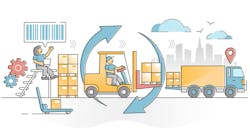Material Handling Tools Improve
Despite the gloomy economic reports, the future looks bright as this year’s DC Expo and Supply Chain Expo exhibitors demonstrated new features geared to boost your e-commerce and supply chain initiatives.
by Leslie Langnau, senior technical editor
It’s been a tight first half for businesses in 2001. It’s no secret that many e-commerce and supply-chain initiatives are struggling to achieve profitability, let alone success. A silver lining in these developments, however, is that the hype and hot air swirling around these business models are finally settling, enabling more realistic thinking. Contrary to recent marketing, there is no “magic-bullet” software package or system solution for establishing a viable e-based supply chain. As most material handling managers and engineers know, and have known, it will take a lot of hard work.
Much of this hard work, noted Dr. Ed Frazelle; president and CEO, Logistics Resources International, during his Supply Chain Expo remarks. It involves each company putting its own internal operations in order before it readies to partner with others in a supply chain. This means measuring and improving forecast accuracy, reducing lead times in every supply chain link, reducing purchase order costs, eliminating supply chain blind spots and lowering the cost of owning inventory. (A side note here: on average, more than 40 percent of U.S. inventory is obsolete.)
Understanding material handling processes and translating that understanding into bits and bytes of software code is an iterative process. Each year, software becomes more capable and flexible, and this year’s vendors demonstrated some interesting advances that may go a long way toward helping managers meet Dr. Frazelle’s list of supply chain enablers. If you couldn’t find a feature you needed, keep your eyes open. Chances are it will show up soon.
Here’s a brief list of some of the areas industry is focusing on, with more detail on a few key items following:
• The underutilization of software features and functions;
• Integration;
• Developing flexible, configurable software;
• Addressing the e-commerce and supply-chain needs of small and mid-sized firms;
• Inventory with a view — improving access to inventory and supply-chain transactions; reducing paperwork, manual data entry and duplication of data. Along with this, improving inventory forecasting and inventory management.
• Rolling out XML;
• Increasing the availability of wireless solutions.
Taking more advantage
Businesses are spending millions on new technology, but it’s the rare company that makes full use of all the available features it has bought. Commented Gil Bautista Jr., president, Vertex Enterprise, part of the problem involves the cost of the system and its implementation process. But other issues have nothing to do with technology and everything to do with management. They include little or no executive sponsorship, lack of an enterprise-wide buy-in, no clear-cut objectives and benefits, little or no IT support, as well as workforce resistance to new processes and a desire to force old processes to adapt.
According to Luis Solis, CEO, Symbius, companies typically receive only 25 percent of the benefits software companies promise for e-procurement technology. Attaining 100 percent requires an up-front supply chain strategy, supplier education and business process realignment. Buying the software is the easy part.
“Typically, companies run out of time, money or resources to get all the functionality in,” said Michael Wohlwend, eSync practice leader. “But it’s that last 15 percent to 20 percent of the functionality that accounts for a substantial part of the bottom-line ROI and system effectiveness. There is a need to get that functionality implemented.”
Because of these problems of cost and implementation, supply chain technology and services have penetrated less than 26 percent of companies, regardless of their size, claimed Deep R. Parekh, CEO, PlanCentral Inc. In addition, the six to nine months it usually takes to implement these solutions puts them out of reach for small and mid-size enterprises.
To combat this, vendors are examining ways to help companies get everything they’ve already paid for. Customer service was a constant mention at the shows. And for the smaller guys, vendors like Manhattan Associates introduced packages specifically geared toward their needs.
Islands of information
Integration, the lack of it and the huge need for it, was on a lot of people’s minds. “But the major challenge is not technology,” said Bautista, “it’s managing the business to facilitate the successful integration and effective use of technology.”
In his DC Expo seminar, Bautista said that more than 50 percent of companies surveyed had no e-commerce initiatives, 25 percent were not well integrated, 19 percent were satisfied with their channels, and 4 percent considered themselves well integrated. Obviously, there’s much work to be done.
Part of the solution is a category of software known as middleware. These programs, which began in the IT and networking industries, let systems easily share data regardless of the system platform. Several were also demonstrated at Supply Chain Expo. Some involve “mapping,” a technique that translates the native language of one business system into a common language, passing it on to another program and translating it into that program’s language, and reversing the process for return data. Such programs will integrate legacy systems with newer solutions.
Most executives were optimistic that, eventually, all routine business transactions would be done electronically in real time. Protocols will favor integration.
XML and EDI
The push to convert to extensible markup language (XML) is strong; however many companies still use EDI and are quite happy with it. According to sources at Neon Systems Inc., EDI accounted for more than $215 billion in commercial transactions in 1999. But these systems’ cost and maintenance requirements tend to limit their use to the largest corporations. In fact, all Tier 1 companies in the automotive industry use EDI. Tier 2 and 3 companies, however, still use mostly phone, fax and mail.
The Internet, which is virtually free by comparison, and XML are attractive alternatives to EDI for these smaller companies. Plus, such companies don’t have a legacy system to contend with. Thus, executives and analysts agree XML will become the protocol of choice.
But XML has a few problems of its own. Companies developing XML product are still trying to sew up market share and develop the de facto version. Thus, this package delivery system comes in many versions, complicating true interconnection.
Most companies are developing connections to XML even so, as, presently there is no other alternative. The reality is that likely both systems will be called upon to work together.
Have it your way
The quest for better inventory management goes on. In many cases, excess inventory is the result of engineering changes, poor sales forecasts or production problems.
Often compounding these problems were ERP, WMS, WCS and other software management systems that forced managers to conform to the way such programs insisted a company run its business. But conforming did not always succeed, as has been demonstrated by several high-profile companies abandoning their projects in mid-installation.
The next crop of inventory control software is more flexible, adapting to the way you do business. You can expect other features as well. One will be custom-configurable messaging. Instead of being forced to receive a specific set of messages when you want only one or two, you will be able to activate just the ones you want.
Exception handling is another feature desired but rarely seen. In some packages, the program can check a list of steps to take when it receives data on a specific event. You program in what steps you want it to allow, from simply alerting you to this event, to going ahead and dialing up alternate supplier B, C or D for a part or product and scheduling shipment.
The latest software is also offering better views of inventory, including real-time viewing. A strategic alliance between Lockheed Martin Management & Data Systems and Viewlocity, for example, has resulted in such a solution.
One technology that vendors plan to develop is giving supply chain partners the ability to change supply chain plans weekly, even daily, to find the optimum operating arrangement. Technology can do this. But are members of the supply chain ready? Could members react quickly enough? Right now, the answer is likely no, as companies have much work to do, inside and outside their walls, to ready their supply chains.
Managers need to keep in mind that technology is necessary, but it’s not the only element needed for a great supply chain. Most business units still make decisions autonomously. Even within an organization, department managers make decisions with little awareness of the effect they may have on other departments. Engineering change orders, for example, are one of the reasons there’s so much obsolete inventory in U.S. facilities.
Soon, however, you’ll see software that combines key performance indicators of various departments to better manage inventory.
Moving out
And, lastly, outsourcing of all but core functions continues with many companies. Warehousing, for example, is rapidly becoming the core function of 3PLs and 4PLs. As one exhibitor explained, these businesses can leverage the rising costs of material handling equipment better over several customers. SCF


